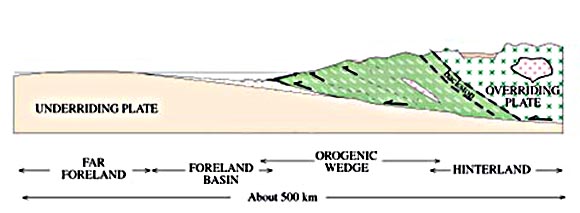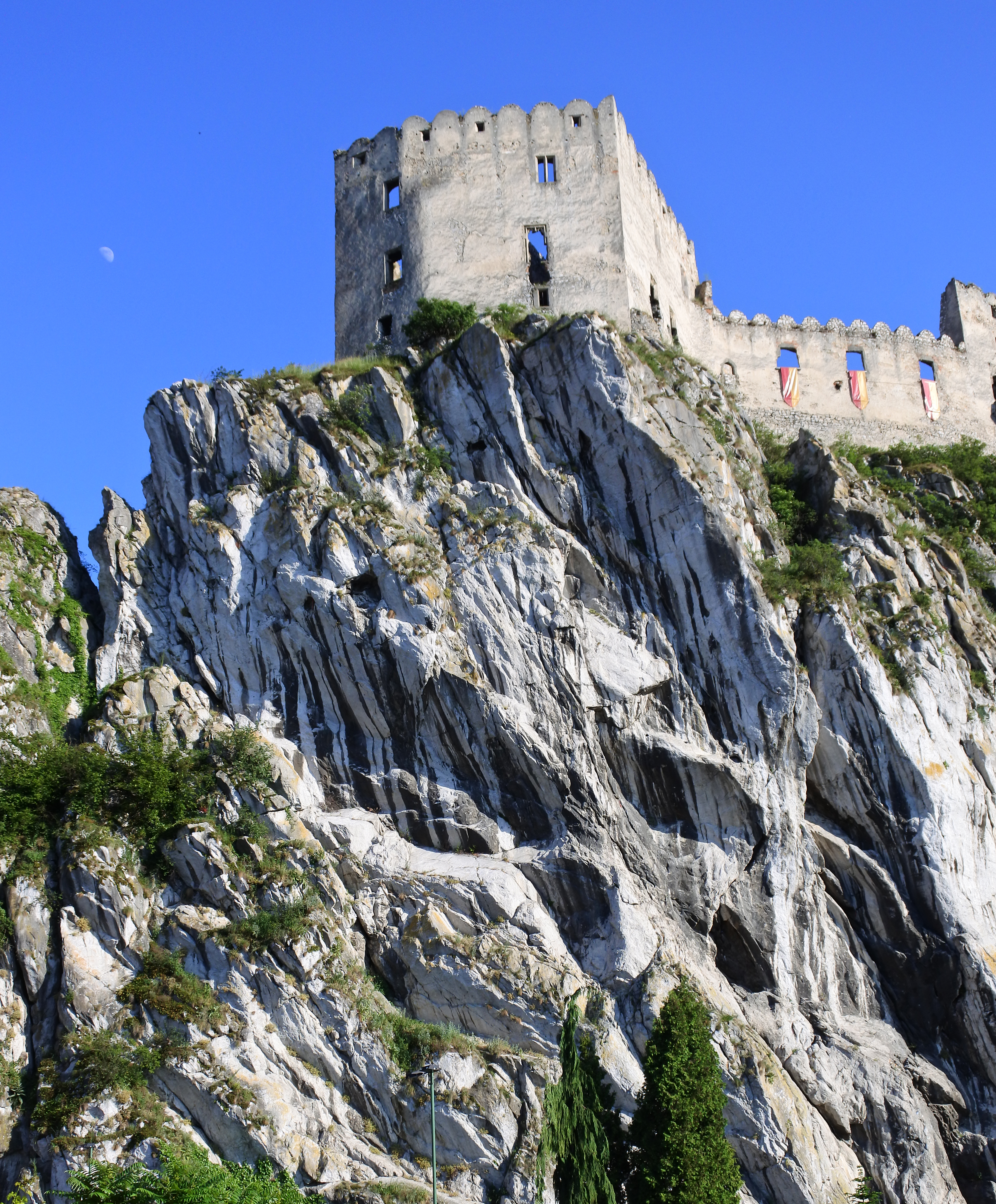|
Nappe
In geology, a nappe or thrust sheet is a large sheetlike body of rock (geology), rock that has been moved more than or above a thrust fault from its original position. Nappes form in compressional tectonic settings like continental collision zones or on the overriding plate in active subduction zones. Nappes form when a mass of rock is forced (or thrust fault, "thrust") over another rock mass, typically on a low angle fault plane. The resulting structure may include large-scale recumbent Fold (geology), folds, shearing along the fault plane,Twiss, Robert J. and Eldridge M. Moores, ''Structural Geology,'' W. H. Freeman, 1992, p. 236 Thrust fault#Thrust duplex, imbricate thrust stacks, Window (geology), fensters and klippes. The term stems from the French word for ''tablecloth'' in allusion to a rumpled tablecloth being pushed across a table. History Nappes or nappe belts are a major feature of the European Geology of the Alps, Alps, Dinaric Alps, Dinarides, Carpathians and S ... [...More Info...] [...Related Items...] OR: [Wikipedia] [Google] [Baidu] |
Geology Of The Alps
The Alps form part of a Cenozoic orogenic belt of mountain chains, called the Alpide belt, that stretches through southern Europe and Asia from the Atlantic all the way to the Himalayas. This belt of mountain chains was formed during the Alpine orogeny. A gap in these mountain chains in central Europe separates the Alps from the Carpathians to the east. Orogeny took place continuously and tectonic subsidence has produced the gaps in between. The Alps arose as a result of the collision of the African and Eurasian tectonic plates, in which the Alpine Tethys, which was formerly in between these continents, disappeared. Enormous stress was exerted on sediments of the Alpine Tethys basin and its Mesozoic and early Cenozoic strata were pushed against the stable Eurasian landmass by the northward-moving African landmass. Most of this occurred during the Oligocene and Miocene epochs. The pressure formed great recumbent folds, or ''nappes'', that rose out of what had been the Alp ... [...More Info...] [...Related Items...] OR: [Wikipedia] [Google] [Baidu] |
Window (geology)
350px, Schematic overview of a thrust system. The hanging wall block is (when it has reasonable proportions) called a nappe. If an erosional hole is created in the nappe that is called a window. A klippe">erosion.html" ;"title="nappe. If an erosion">nappe. If an erosional hole is created in the nappe that is called a window. A klippe is a solitary outcrop of the nappe in the middle of autochthonous material. A tectonics, tectonic window, or fenster (lit. "window" in German language, German), is a geology, geologic structure formed by erosion or normal faulting on a thrust fault, thrust system. In such a system the rock mass ( fault (geology), hanging wall block) that has been transported by movement along the thrust is called a nappe. When erosion or normal faulting produces a hole in the nappe where the underlying autochthonous (i.e. un-transported) rocks crop out this is called a window. Klippen are also a feature near windows. The klippe is the remnant portion of a nappe aft ... [...More Info...] [...Related Items...] OR: [Wikipedia] [Google] [Baidu] |
Marcel Alexandre Bertrand
Marcel Alexandre Bertrand (2 July 1847 – 13 February 1907) was a French geologist born in Paris. He was the son of mathematician Joseph Louis François Bertrand (1822–1900), and son-in-law to physicist Éleuthère Mascart (1837-1908). He studied at the École Polytechnique, and beginning in 1869 he attended the Ecole des Mines de Paris. From 1877 he carried out geological mapping studies of Provence, the Jura Mountains and the Alps. In 1886, he became an instructor at the École Nationale Supérieure des Mines, and in 1896 became a member of the Académie des sciences. Bertrand, a founder of modern tectonics, originated an orogenic "wave theory" of mountain-building and introduced the nappe hypothesis (). His wave theory described a build-up of massive folds of earth taking place over successive geological eras, called the Caledonian, Hercynian and Alpine periods of orogeny. Bertrand later added a fourth event called the Huronian orogeny, which took place 2400 to 2100 mill ... [...More Info...] [...Related Items...] OR: [Wikipedia] [Google] [Baidu] |
Klippe
350px, Schematic overview of a thrust system. The shaded material is called a window_(geology).html"_;"title="nappe._The_erosional_hole_is_called_a__window_(geology)">window_or_fenster._The_klippe_is_the_isolated_block_of_the_nappe_overlying_autochthonous_material. A_klippe_(German_language.html" "title="window (geology)">window or fenster. The klippe is the isolated block of the nappe overlying autochthonous material.">window_(geology).html" ;"title="nappe. The erosional hole is called a window (geology)">window or fenster. The klippe is the isolated block of the nappe overlying autochthonous material. A klippe (German language">German for cliff or crag) is a geological feature of thrust fault terrains. The klippe is the remnant portion of a nappe after erosion has removed connecting portions of the nappe. This process results in an outlier of exotic, often nearly horizontally translated strata overlying autochthonous strata. Examples of klippes include: *Chief Mountain, Mont ... [...More Info...] [...Related Items...] OR: [Wikipedia] [Google] [Baidu] |
Carpathians
The Carpathian Mountains or Carpathians () are a range of mountains forming an arc across Central Europe. Roughly long, it is the third-longest European mountain range after the Ural Mountains, Urals at and the Scandinavian Mountains at . The range stretches from the far eastern Czech Republic (3%) and Austria (1%) in the northwest through Slovakia (21%), Poland (10%), Ukraine (10%), Romania (50%) to Serbia (5%) in the south. "The Carpathians" European Travel Commission, in The Official Travel Portal of Europe, Retrieved 15 November 2016 ... [...More Info...] [...Related Items...] OR: [Wikipedia] [Google] [Baidu] |
Maurice Lugeon
Maurice Lugeon FRS(For) HFRSE FGS (10 July 1870 – 23 October 1953) was a Swiss geologist, and the pioneer of nappe tectonics. He was a pupil of Eugène Renevier. Named for Maurice Lugeon, the lugeon is a measure of transmissivity in rocks, determined by pressurized injection of water through a bore hole driven through the rock. One Lugeon (Lu) is equivalent to one litre of water per minute, injected into 1 metre of borehole at an injection pressure of 10 atmospheres. Life He was born in Poissy near Paris on 10 July 1870. His family moved to Lausanne in Switzerland in 1876. From the age of 15 he showed a strong interest in geology. He spent most of his academic life at the University of Lausanne becoming Professor of Geology in 1906. He retired in 1940. He became an expert on dam locations and was consulted widely on this. He died in Lausanne in Switzerland ). Swiss law does not designate a ''capital'' as such, but the federal parliament and government are installed ... [...More Info...] [...Related Items...] OR: [Wikipedia] [Google] [Baidu] |
Continental Collision
In geology, continental collision is a phenomenon of plate tectonics that occurs at convergent boundaries. Continental collision is a variation on the fundamental process of subduction, whereby the subduction zone is destroyed, mountains produced, and two continents sutured together. Continental collision is only known to occur on Earth. Continental collision is not an instantaneous event, but may take several tens of millions of years before the faulting and folding caused by collisions stops. The collision between India and Asia has been going on for about 50 million years already and shows no signs of abating. Collision between East and West Gondwana to form the East African Orogen took about 100 million years from beginning (610 Ma) to end (510 Ma). The collision between Gondwana and Laurasia to form Pangea occurred in a relatively brief interval, about 50 million years long. Subduction zone: the collision site The process begins as two conti ... [...More Info...] [...Related Items...] OR: [Wikipedia] [Google] [Baidu] |
Duplex (geology)
Duplex (Latin, 'double') may refer to: Arts and entertainment * ''Duplex'' (film), or ''Our House'', a 2003 American black comedy film * Duplex (band), a Dutch electronic music duo * Duplex (Norwegian duo) * Duplex!, a Canadian children's music band * '' The Duplex'', an American comic strip by Glenn McCoy * ''The Duplex'' (film), a 2015 Nigerian film Places * Duplex, Tennessee, U.S. * Duplex, Texas, U.S. Science and technology * ''Duplex'' (moth), a genus of moths in the family Erebidae * Nucleic acid double helix, a double-stranded molecule of DNA or RNA * Duplex (telecommunications), communications in both directions simultaneously * Duplex (typography), a Linotype technique * Duplex ultrasonography, a medical imaging technique * Google Duplex, an extension of Google Assistant Transportation * Duplex (automobile), an early car built in Canada in 1923 * Duplex locomotive, a type of steam locomotive * TGV Duplex, a French high-speed train of the TGV family featuring ... [...More Info...] [...Related Items...] OR: [Wikipedia] [Google] [Baidu] |
Suture (geology)
In structural geology, a suture is a joining together along a major fault zone, of separate terranes, tectonic units that have different plate tectonic, metamorphic and paleogeographic histories. The suture is often represented on the surface by an orogen or mountain range. Overview In plate tectonics, sutures are the remains of subduction zones, and the terranes that are joined together are interpreted as fragments of different palaeocontinents or tectonic plates. Outcrops of sutures can vary in width from a few hundred meters to a couple of kilometers. They can be networks of mylonitic shear zones or brittle fault zones, but are usually both. Sutures are usually associated with igneous intrusions and tectonic lenses with varying kinds of lithologies from plutonic rocks to ophiolitic fragments. An example from Great Britain is the Iapetus Suture which, though now concealed beneath younger rocks, has been determined by geophysical means to run along a line roughly paralle ... [...More Info...] [...Related Items...] OR: [Wikipedia] [Google] [Baidu] |
Albert Heim
Albert Heim (12 April 184931 August 1937) was a Swiss geologist, noted for his three-volume ''Geologie der Schweiz''. Born in Zürich, he was educated at Zürich and Berlin universities. Very early in life he became interested in the physical features of the Alps, and at the age of sixteen he made a model of the Tödi group. This came to the notice of Arnold Escher von der Linth, to whom Heim was indebted for much encouragement and geological instruction in the field. In 1873 he became professor of geology in the polytechnic school at Zürich, and in 1875 professor of geology in the university. In the same year he married Marie Heim-Vögtlin, Switzerland's first woman physician. In 1882 he was appointed director of the Geological Survey of Switzerland, and in 1884 the honorary degree of PhD was conferred upon him at the University of Berne. He was especially distinguished for his researches on the structure of the Alps and for the light thereby thrown on the structure of mount ... [...More Info...] [...Related Items...] OR: [Wikipedia] [Google] [Baidu] |



